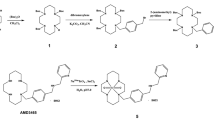Abstract
This research aimed to prepare 99mTc-/177Lu-CXCR4-L radiotracers and evaluate their in vitro and in vivo capability to detect the chemokine-4 receptor. Molecular docking calculations, Kd values (< 10 nM) of 99mTc-/177Lu-CXCR4-L (radiochemical purities > 98.5%) estimated by saturation binding assays, as well as biodistribution studies in mice with induced tumors, confirmed the affinity of radiotracers towards CXCR4, expressed in DU-4475 breast cancer cells and C6 glioblastoma cells. Micro-SPECT/CT images showed that 99mTc-CXCR4-L and 177Lu-CXCR4-L could work as a theranostic pair for CXCR4 targets. Results warrant additional research to assess the therapeutic efficacy and dosimetry of 177Lu-CXCR4-L.







Similar content being viewed by others
References
Lapa C, Lückerath K, Kleinlein I et al (2016) (68)Ga-Pentixafor-PET/CT for imaging of chemokine receptor-4 expression in glioblastoma. Theranostics 6:428–434
Gourni E, Demmer O, Schottelius M et al (2011) PET of CXCR4 expression by a (68)Ga-labeled highly specific targeted contrast agent. J Nucl Med 52:1803–1810
Herrmann K, Lapa C, Wester HJ et al (2015) Biodistribution and radiation dosimetry for the chemokine receptor CXCR4-targeting probe 68 Ga-pentixafor. J Nucl Med 56:410–416
Hartimath SV, van Waarde A, Dierckx RA et al (2014) Evaluation of N-[(11)C]methyl-AMD3465 as a PET tracer for imaging of CXCR4 receptor expression in a C6 glioma tumor model. Mol Pharm 11:3810–3817
Tamamura H, Omagaria A, Oishi S et al (2000) Pharmacophore identification of a specific CXCR4 inhibitor, T140, leads to development of effective anti-HIV agents with very high selectivity indexes. Bioorg Med Chem Lett 10:2633–2637
Fujii N, Oishi S, Hiramatsu K et al (2003) Molecular-size reduction of a potent CXCR4-chemokine antagonist using orthogonal combination of conformation- and sequence-based libraries. Angew Chem Int 42:3251–3253
Demmer O, Gourni E, Schumacher U et al (2011) PET Imaging of CXCR4 receptors in cancer by a new optimized ligand. ChemMedChem 6:1789–1791
Mikaeili A, Erfani M, Shafiei M et al (2018) Development of a 99mTc-Labeled CXCR4 antagonist derivative as a new tumor radiotracer. Cancer Biother Radiopharm 33:17–24
Wu B, Chien EYT, Mol CD et al (2010) Structures of the CXCR4 chemokine receptor in complex with small molecule and cyclic peptide antagonists. Science 330:1066–1071
Thoma G, Streiff MB, Kovarik J et al (2008) Orally bioavailable isothioureas block function of the chemokine receptor CXCR4 in vitro and in vivo. J Med Chem 51:7915–7920
Hanwell MD, Curtis DE, Lonie DC et al (2012) Avogadro: an advanced semantic chemical editor, visualization, and analysis platform. J Cheminform 4:17
Pettersen EF, Goddard TD, Huang CC et al (2004) UCSF Chimera—a visualization system for exploratory research and analysis. J Comput Chem 25:1605–1612
Trott O, Olson AJ (2010) AutoDock Vina: improving the speed and accuracy of docking with a new scoring function, efficient optimization and multithreading. J Comput Chem 31:455–461
Mungalpara J, Zachariassen ZG, Thiele S et al (2013) Structure-activity relationship studies of the aromatic positions in cyclopentapeptide CXCR4 antagonists. Org Biomol Chem 11:8202–8208
Choy CJ, Ling X, Geruntho JJ et al (2017) 177Lu-Labeled phosphoramidate-based PSMA inhibitors: the effect of an albumin binder on biodistribution and therapeutic efficacy in prostate tumor-bearing mice. Theranostics 7:1928–1939
Wester HJ, Keller U, Schottelius M et al (2015) Disclosing the CXCR4 expression in lymphoproliferative diseases by targeted molecular imaging. Theranostics 5:618–630
Wüstemann T, Bauder-Wüst U, Schäfer M et al (2016) Design of internalizing PSMA-specific Glu-ureido-based radiotherapeuticals. Theranostics 6:1085–1095
Kufareva I, Stephens BS, Holden LG et al (2014) Stoichiometry and geometry of the CXC chemokine receptor 4 complex with CXC ligand 12: molecular modeling and experimental validation. Proc Natl Acad Sci USA 111:E5363–E5372
Hattermann K, Holzenburg E, Hans F et al (2014) Effects of the chemokine CXCL12 and combined internalization of its receptors CXCR4 and CXCR7 in human MCF-7 breast cancer cells. Cell Tissue Res 357:253–266
Escudero-Castellanos A, Ocampo-Garcia B, Ferro-Flores G et al (2017) Preparation and in vitro evaluation of 177Lu-iPSMA-RGD as a new heterobivalent radiopharmaceutical. J Radioanal Nucl Chem 314:2201–2207
Rubin JB, Kung AL, Klein RS et al (2003) A small-molecule antagonist of CXCR4 inhibits intracranial growth of primary brain tumors. Proc Natl Acad Sci USA 100:13513–13518
Tamamura H, Hori A, Kanzaki N et al (2003) T140 analogs as CXCR4 antagonists identified as anti-metastatic agents in the treatment of breast cancer. FEBS Lett 28:79–83
Smith MC, Luker KE, Garbow JR et al (2004) CXCR4 regulates growth of both primary and metastatic breast cancer. Cancer Res 64:8604–8612
Takenaga M, Tamamura H, Hiramatsu K et al (2004) A single treatment with microcapsules containing a CXCR4 antagonist suppresses pulmonary metastasis of murine melanoma. Biochem Biophys Res Commun 320:226–232
Acknowledgements
This research received financial support from the Mexican National Council of Science and Technology (CONACyT-Mexico, Grant CB2017-2018-A1-S-36841). This work was performed as part of the activities of the ‘‘Laboratorio Nacional de Investigación y Desarrollo de Radiofármacos, CONACyT’’.
Author information
Authors and Affiliations
Corresponding authors
Ethics declarations
Conflict of interest
The authors declare no potential conflicts of interest with regard to the research, authorship, and/or publication of this article.
Ethical approval
All applicable international, national and/or institutional guidelines for the care and use of animals were followed. This research was approved by the CICUAL-ININ Ethics Committee (Internal Committee of Care and Use of Laboratory Animals of the National Institute of Nuclear Research, Approval No. 02-2018).
Additional information
Publisher's Note
Springer Nature remains neutral with regard to jurisdictional claims in published maps and institutional affiliations.
Rights and permissions
About this article
Cite this article
Ávila-Sánchez, M., Ferro-Flores, G., Jiménez-Mancilla, N. et al. Synthesis and preclinical evaluation of the 99mTc-/177Lu-CXCR4-L theranostic pair for in vivo chemokine-4 receptor-specific targeting. J Radioanal Nucl Chem 324, 21–32 (2020). https://doi.org/10.1007/s10967-020-07043-6
Received:
Published:
Issue Date:
DOI: https://doi.org/10.1007/s10967-020-07043-6




